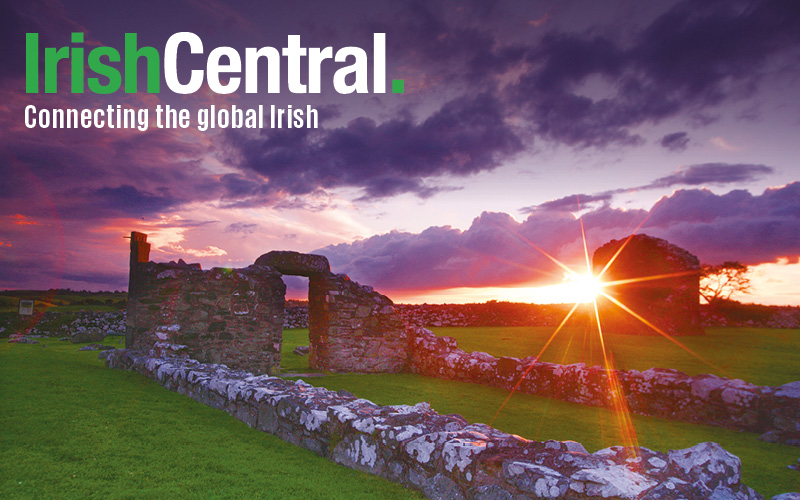How, in a nation brimming with crops and surrounded on all sides by teeming seas, could the Irish people have starved in their millions in the middle of the 19th century?
The answer, according to noted Irish historian Tim Pat Coogan, is as unsettling as it is direct.
The biggest contributing factor to the Great Irish Hunger was that because of conquest, Ireland was a dependency with no government of its own between 1845 and 1852. It’s a dangerous and isolating scenario that Coogan suggests may be playing out still.
“As I wrote The Famine Plot I got an increasingly bad feeling. The reason that most of what occurred during the famine happened to the Irish was because we didn’t have a government,” he told the Irish Voice during a phone interview last week, not long after his highly publicized visa battle with the U.S. Embassy in Dublin was settled.
“We’re back to that now. We have lost our sovereignty and are depending on doles from Brussels, the IMF and so on. And we’re back to unemployment, emigration and suicide – and of course, to learned helplessness.”
That last condition, which arises from the long-term legacy of colonization and from the despair of never being able to master your own fate, has characterized so much of the Irish response to political and social challenges since the great hunger, Coogan contends.
For decades now Coogan, 77, one of Ireland’s most prominent historians and the former editor of The Irish Press, has studied the impact and consequences of the Great Hunger on the nation, and his research has now led to his new work The Famine Plot, his hard-hitting exploration of the most traumatic event in Irish history.
Perhaps the first and most remarkable thing about the legacy of the Great Hunger is the silence that immediately followed it. For almost a 100 years Irish historians and Irish officialdom were reluctant to address it because they were leery of its enormous emotive and political power.
Interestingly, Coogan was himself prevented from undertaking his own U.S. book tour to promote The Famine Plot due to being twice refused a visa by the American Embassy in Dublin last month. On his personal website he spoke of his unease over the unprecedented decision.
“Somebody, somewhere it appears did not want me to visit the United States to publicize my book on the Famine. It was suggested to me that some securicrats in the U.S. Embassy had decided to do a good turn for their buddies in the British ‘spookdom’ by blocking my attempts to enter the United States on a book tour,” he said.
If this is true then the Great Hunger (and British officialdom’s response to it) has lost none of its power to unnerve. But how can you really postpone an honest telling of how upward of two million Irish people died without that being an insult to their dignity as people?
“I had been applying fruitlessly for a visa since September but inexplicably had two separate visa waivers turned down and finally after much unhelpful gobbledygook from the U.S. Embassy, had to apply for a non-immigrant visa,” Coogan explains.
At 77, now an undisputed elder statesman, it’s baffling that he could be considered a security risk.
If it turns out to be true that the British exerted political pressure on the U.S. to block or at least postpone Coogan’s book tour, they needn’t have worried. Coogan is at pains to point out it in his book that it was not the British public who were responsible for the Great Hunger.
Instead he lays the blame at British officialdom and the often absentee land owning classes which pursued a reckless or opportunistic course of action that exacerbated or exploited conditions on the ground.
For decades, Coogan contends, both British and Irish historians skirted the question of where to lay blame. He also knows why.
“I used to argue a lot about it because of the revisionist historians. It was as if they wanted us to consider the Famine as a sort of 19th century precursor to the Scarsdale Diet (a low fat, low calorie weight loss diet) and not a famine,” he said.
Eyewitnesses of the period like Earl Gray, the then colonial secretary, were in no doubt where the buck stopped.
“We have a military occupation of Ireland,” he told the House of Lords in March 1846, “but in no other sense can it be said to be governed. It (is) occupied by troops, not governed like England.”
It was apparent to Coogan that this central fact, Britain’s misgoverning of an otherwise ignored and dependent colony, was the lynchpin of the crisis.
“But I found that the angle that’s given in most of the studies, is that academics will try to break it down into those who favor the nationalist cause and those who favor – I’m not quite sure who the other side are meant to be.
“The nationalists have been portrayed as ravening nuts compared with the measure gentlemen who take the Scarsdale approach. It’s a kind of colonial cringe that happens, derived from the fact that most historians until recently were trained in England. They had their eyes on their careers, too, of course.”
The better studies on the Great Hunger have all been written by Irish Americans, Coogan contends, since they are outside the British tenure track loop and don’t have to bow the knee to this kind of shibboleth.
“Christine Kinealy, James Donnelly Junior, Bob Scally – all these guys have written about the Famine in a moving way and are above reproach. They don’t follow a hidebound path.”
Unlike their illustrious predecessors, these Irish American historians don’t give credence to the idea that it didn’t matter that food was exported from Ireland during the Famine. Nor have they shied away from examining the impact and legacy on the people who experienced it and their descendents.
“Two million died. It is two million by the way because modern scholarship shows that the loss to the birth rate was more than just a million. Whole families perished and there’s no records. The fevers were devastating and then there were all the diverted births, of children born on ships or born in America,” Coogan explains.
“We lost through death and emigration three million out of a population of nearly nine. There was a psychological aspect to it too, a condition called learned helplessness where the experience is so overwhelming that you simply accept your fate. That learned helplessness has played itself out in all the decades that have followed.”
It didn’t help that a chorus of high-handed British officials saw the subsequent death of millions of Irish paupers as “God’s lesson” for their supposedly shiftless neighbors, Coogan says.
In The Famine Plot Coogan underlines how a toxic stew of anti-Irish sentiment, amoral economic opportunism and longstanding religious discrimination, led – he maintains – to one of the earliest examples of how an engineered food shortage became a covert policy of ethnic cleansing.
Whether you accept this claim or not, that British officialdom pursued a premeditated policy to let Irish paupers die, or whether you believe that laissez-faire economics and political indifference (which is in some ways worse) led to mass starvations, there’s no question that it’s the darkest chapter in Britain’s colonial past.
Many Irish readers will be familiar with the details of the Irish Famine, the numbers who died, the dangerous voyages on coffin ships in search of relief, and the legacy of that crisis on the Irish diaspora of nearly 80 million people.
But nothing can prepare you for the book’s emotional wallop, as Coogan vividly recreates the hell on earth conditions that our ancestors navigated and then were haunted by after the fact. Their voices, the needless horror they witnessed, have rarely been so passionately expressed.




Comments